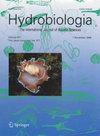墨西哥华图尔科珊瑚礁上造礁物种的宏观侵蚀及其对碳酸盐收支的影响
IF 0.3
4区 生物学
Q4 MARINE & FRESHWATER BIOLOGY
引用次数: 0
摘要
背景。珊瑚礁的存在要归功于钙化和侵蚀过程之间的微妙平衡。然而,由于人为压力,生物侵蚀过程已成为珊瑚礁生长模式的主要强迫因素。然而,由于位于墨西哥南太平洋的珊瑚礁的形态(广泛的盆孔虫板块),估计内部大型生物侵蚀是一项挑战,导致生物侵蚀过程,特别是发生在珊瑚内部的生物侵蚀过程存在关键空白。目标。测量主要珊瑚物种的内部宏观侵蚀,了解其对珊瑚礁碳酸盐生成的影响。方法。我们使用基于计算机断层扫描(CT)的方法来测量不同组的大型侵蚀菌去除CaCO3的体积。结果。我们估计内部大型生物侵蚀的百分比在16.80%到26.67%之间。我们观察到海绵和软体动物分别是最具分枝形态和块状形态的生物侵蚀物种。结果表明,枝状物种的宏观侵蚀速率为1.51±0.11 kg CaCO3 m-2年-1,块状物种的宏观侵蚀速率为0.53±0.03 kg CaCO3 m-2年-1。测定的生物侵蚀过程分别占CaCO3产量的39.02%和43.86%。结论。尽管CT扫描比其他方法(如x射线)成本更高,但它是唯一能够测量整个珊瑚骨架内部宏观生物侵蚀的方法。这种方法将使我们能够比那些不考虑内部宏观生物侵蚀的方法产生更准确的碳酸盐平衡,从而提高我们对珊瑚礁健康状况的估计。本文章由计算机程序翻译,如有差异,请以英文原文为准。
Macrobioerosion of the coral reef-building species and impact on carbonate budgets on the reefs of Huatulco, Mexico
Background. Coral reefs exist thanks to the delicate balance between calcification and erosion processes. However, due to anthropogenic pressures, bioerosive processes have become the main forcing factors in reef growth patterns. Nevertheless, due to the morphology of the reefs located in the Mexican South Pacific (extensive plates of pociloporids), estimating internal macrobioerosion is a challenge, resulting in a critical gap in bioerosion processes, particularly those occurring inside corals. Objectives. To measure the internal macrobioerosion of the main coral species and to know its impact on carbonate production in reefs. Methods. We used a computed tomography (CT) based approach to measure the volume of CaCO3 removed by different groups of macrobioeroders. Results. We estimated percentages of internal macrobioerosion between 16.80 % and 26.67 % of the total volume of the colonies. We observed that sponges and mollusks are the guilds that most bioerode species of branching and massive morphology, respectively. We found macrobioerosion rates of 1.51 ± 0.11 kg CaCO3 m-2 yr-1 for branched species and 0.53 ± 0.03 kg CaCO3 m-2 yr-1 for massive species. The measured bioerosion processes accounted for 39.02 % and 43.86 % of CaCO3 production. Conclusions. Although CT scanning represents higher costs than other approaches (i.e., X-rays), it is the only approach capable of measuring the internal macrobioerosion that occurs within the entire coral skeleton. This approach will allow us to produce more accurate carbonate balances than those that do not consider internal macrobioerosion, improving our estimates of the state of health of the reefs.
求助全文
通过发布文献求助,成功后即可免费获取论文全文。
去求助
来源期刊

Hidrobiologica
生物-海洋与淡水生物学
CiteScore
0.40
自引率
0.00%
发文量
8
审稿时长
>12 weeks
期刊介绍:
HIDROBIOLÓGICA es una publicación cuatrimestral que difunde trabajos originales e inéditos de investigación o revisión, sobre temas relacionados con los organismos y la hidrología de los ambientes acuáticos, dulces y marinos y va dirigida a investigadores de todo el mundo, interesados en las diversas disciplinas que incluye la Hidrobiología , así como a alumnos de posgrados y licenciaturas relacionados con la biología, ecología, taxonomía, filogenia y evolución de organismos acuáticos, e hidrología y oceanografía de ambientes s dulceacuícolas y marinos.
 求助内容:
求助内容: 应助结果提醒方式:
应助结果提醒方式:


